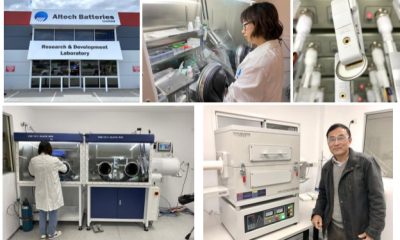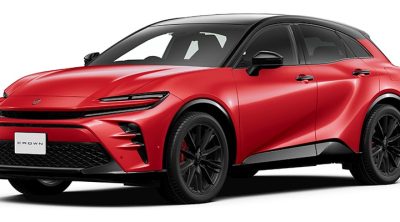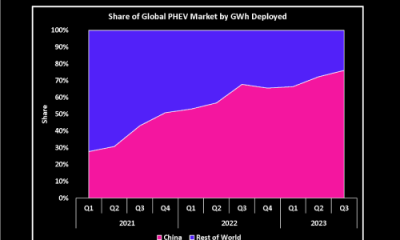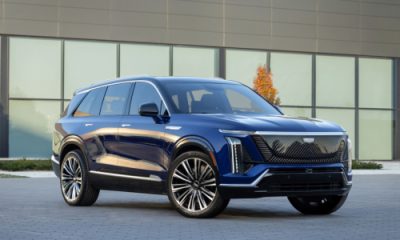Energy & Critical Metals
Emissions Analytics argues that current Pareto-efficient solution for decarbonization would be hybrids, not BEVs, based on do-no-harm
Based on comparison tests between a Tesla Model Y and Kia Niro full hybrid, independent emissions testing company Emissions Analytics (earlier post) is…
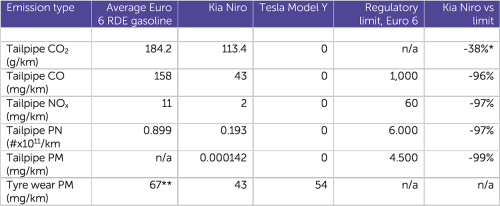
Based on comparison tests between a Tesla Model Y and Kia Niro full hybrid, independent emissions testing company Emissions Analytics (earlier post) is suggesting that at present full hybrids are the win-win, do-no-harm option for decarbonizing transportation, while BEVs are a win-lose option, hampered by a “vexatious” trade-off between CO2 reductions and increased in-use vehicle emissions—specifically from tire wear particles as well as off-gased VOCs from the tires.
On this basis, and of Pareto efficiency, Emissions Analytics argues, until battery-electric vehicles can reach certain performance characteristics, government and industry support should switch immediately from EVs to full hybrids to create maximum welfare.
Resources are scarce, and the job of decarbonisation is big, so we need to invest our money carefully. One way to judge this is to consider an alternative measure of optimality: Pareto efficiency. Vilfredo Pareto was a nineteenth century Italian economist, who described a system being Pareto efficient when is not possible to change the allocation of goods without harming at least one person. Interpreting that for transport decarbonisation, we can say that a change of powertrain can be a Pareto improvement if it is possible to improve all relevant aspects without disadvantage to someone. For clarity, following Pareto improvements does not necessarily lead us to the globally best outcome, but offers relatively easy ‘wins-wins’, opportunities which are scarce in complex modern economies.
—Emissions Analytics
Emissions Analytics compared the two vehicles using its real-world EQUA test cycle. The two vehicles were less than one year old, had their original tires with similar tread depths, and closely matched mileage. The Tesla is physically slightly larger, and weighs 489 kg (1,078 lbs) more, due mainly to the battery pack.
Acknowledging that a good textbook like-for-like comparison would to have been pairing the Niro hybrid with the Niro EV, Emissions Analytics said that it “is committed to understanding what happens in the real world and, therefore, it would be unwise to the neglect the biggest selling battery electric vehicle (BEV) by revenue in the world in 2022, the Tesla Model Y.”
The vehicles travelled in convoy to eliminate any effects of driving style or climatic conditions. The Kia was instrumented with a tailpipe Portable Emissions Measurement System (PEMS) and the Tesla with an equivalent mass. The test cycle was made up of five repeats of the EQUA cycle, totalling 741 km. At regular points through the test, all the wheels were dismounted, cleaned, weighed and remounted to calculate the mass loss. The results, compared to the relevant regulatory limits, are shown below.
Source: Emissions Analytics
The testing showed that the Kia’s gasoline particulate filter reduced particle mass to almost zero, and particle number to 97% below the Euro 6 regulatory limit. Every air pollutant is more than 90% its limit. Compared to the average of all the current-generation gasoline vehicles the company has tested, the Kia is 38% lower at 113.4 g/km. The Tesla is, of course, zero on all these measures; upstream emissions were ignored in this test.
However, the testing also showed that tire wear particle emissions were five order of magnitude greater than particle mass from the tailpipe of the Kia. Tire wear particle emissions were 26% greater from the Tesla, due to the extra weight and torque, and despite the tires being specifically-designed for electric vehicles. In absolute terms, the increased tire wear from the Tesla over the Kia was 11 mg/km—2.4 times the maximum permissible tailpipe particle mass emissions.
So, as tailpipe air pollutants were tending to zero from the Kia, it is a fair summary to say that a consumer choosing between switching from a traditional gasoline internal combustion engine (ICE) vehicle to either a Kia Niro hybrid or a Tesla Model Y, is weighing up an extra 62% point reduction in CO2 against a 26% increase in particle emissions. However, if full lifecycle CO2 emissions are taken into account, BEVs currently offer around 50% CO2 reduction on average, so in reality the decision to opt for the Tesla is between 12% points of extra CO2 reduction compared to the ICE baseline but 26% more particles.
—Emissions Analytics
In addition to the unaddressed issue of chemicals that leach out of the tire wear particles (TWP) over time, there is also the effect of volatile organic compounds (VOCs) that ‘off-gas’ from the surface of the tire all the time. Similar compounds are also released from the tailpipe; these are regulated as part of a ‘total hydrocarbons’ measure.
During the testing, Emissions Analytics measured tailpipe VOCs using Emissions Analytics’ proprietary sampling equipment that allows a full speciation using two-dimensional gas chromatography and time-of-flight mass spectrometry. Large samples from one tire on each vehicle were also taken and placed in a microchamber heated to 20 degrees Celsius, around the temperature of a vehicle certification test, and held at that level for the same duration of the on-road EQUA test—around three-and-a-half hours. The off-gassed VOCs were analyzed and quantified, and then scaled up by the relative surface area of the sample to that of all four tires on the vehicle. The results are shown below.
Source: Emissions Analytics
This shows that VOCs off-gassed into the air from the tyres are about two orders of magnitude greater than those from the tailpipe of the Kia. Adding the tailpipe and tyre sources, we see that the Kia had total emissions less than half of the Tesla’s. This result is driven by the larger diameter and width of the Tesla tyres, despite their being lower profile.
… In this context, the concept of Pareto improvement is reminiscent of the no-harm principle in medicine: primum non nocere. ‘Do no harm’ means taking a step back from an intervention to look at the broader context and mitigate potential negative effects on the social fabric, the economy and the environment. By switching to FHEVs we can create a ‘no harm’ intervention, unlike BEVs. That is not to say that FHEVs emit literally zero, but no additional harm is done and, in fact, improve all aspects. That is also not to say that BEVs and their associated tyres might not improve—they very likely will. At that point, it would then be right to change policy. To the trade-off described earlier—between 26% more particles as the price of 12% points of extra CO2 reduction—no verdict is passed as to whether this is a good trade-off from a policy point of view, but a trade-off it is.
—Emissions Analytics

Uranium Exploration Company Announces Additional Staking in the Athabasca Basin
Source: Streetwise Reports 12/22/2023
Skyharbour Resources Ltd. announced an update from its Canada-based Falcon Project along with additional…
Tesla Launches New Mega Factory Project In Shanghai, Designed To Manufacture 10,000 Megapacks Per Year
Tesla Launches New Mega Factory Project In Shanghai, Designed To Manufacture 10,000 Megapacks Per Year
Tesla has launched a new mega factory…
Giving thanks and taking stock after “a remarkable year”
An end-of-year thank you to our readers, industry colleagues and advertisers before Electric Autonomy breaks from publishing until Jan. 2
The post Giving…



